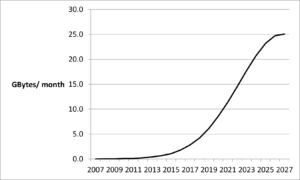

Introduction
This is my third and final blog on the subject of mobile industry profitability and the demands for subsidisation from OTT operators and others. In the first blog, I set out why the problem was not data volumes but industry structure. In the second, I discussed how to change this structure to reduce the competitive intensity, enable differentiation, and prevent uneconomic investment by operators. I will now turn to data to show that data growth is slowing and offloading data to Wi-Fi is better for operators and the environment, meaning operator investment in additional capacity is likely to fall rapidly.
Data growth is slowing
Tefficient produces one of the more authoritative and useful assessments of mobile data usage. The headline of their latest report[1] is “Further slowdown in data usage growth causes ARPU development to soften”. As the title suggests, this report documents how data growth rates have been slowing and are now in the region of 15-20% a year across most countries. A few with higher growth rates, such as Canada, are generally catching up from historically low monthly usage, while some countries have growth rates of less than 5%. This is a far cry from the era of 50%+ annual growth and below the “rule of thumb” of 40% a year growth that Ofcom and others have been using. What is going on?
This is part of a broader trend of slowing growth that has been happening for many years now. It is something I predicted and charted in my book “The 5G Myth” back in 2016, where I predicted the following for the UK (with similar curves for other countries):


This shows growth in usage decreasing and usage eventually plateauing in around 2027. The numbers I predicted back in 2016 for the year 2022 for the UK were 27% growth and 14 GBytes/month average usage. In fact, the UK had 22% growth and 6.5GBytes/month usage, suggesting a lower plateau than I predicted that might occur 1-2 years earlier. My 2016 prediction was that these growth rates will fall by about 5% a year, which still seems likely, so the UK might see around 17% growth next year and 12% in 2025.
The reason is somewhat obvious – without any new way of using our phones, the most data-intensive usage is video, and there are only so many hours a day when anyone wants to watch video on a mobile device. Of course, radical new applications are always possible, but none are likely to achieve mass adoption in the next few years.
If this prediction remains correct, then mobile networks will only need to double capacity between now and the predicted plateau. That should not be a problem for those who already have substantial 3.5 GHz spectrum licences, which provide around a 3x potential for capacity growth depending on actual amounts of spectrum. Such operators will generally not need more spectrum for cellular; they will broadly not need to deploy small cells (at least for reasons of capacity) and they will not need to embark on other offload approaches, such as using unlicensed spectrum. This may be a relief for such operators since they will not need to spend at spectrum auctions or on major network enhancements.
Considering data demands
Society has been demanding evermore data over the last decade or so. Broadly, this is seen as beneficial. Studies suggest that broadband connectivity can raise GDP, and there are concerns that those who have poor connectivity may suffer a digital divide.
However, not all data is equal, and some are clearly much more important than others. Further, there is often scope to be more efficient through the optimal use of compression and considering the use to which the data is being put. A better understanding of where there is scope for reducing data requirements might lead to lower rates of data growth on networks, and hence less of a need to enhance networks to increase capacity.
This is a complex and contentious area that touches on technical capabilities, commercial arrangements, consumer preferences, the potential for abuse of competition, and more. There are clear ways to reduce data volumes, but less clear is whether these would fit within existing regulatory frameworks and political aspirations. Nevertheless, this is a debate worth surfacing and exploring further.
Offloading data
Beyond reducing the volume, another way to address data growth is to transfer the data to other wireless systems – primarily Wi-Fi. Of course, this already happens to a significant degree. While estimates are hard to come by, a few data points suggest something like 70-80% of all the data flow to a mobile phone is via Wi-Fi rather than cellular. And as I pointed out in my first blog, something like 90% of all the data we consume travels via broadband to Wi-Fi and then to our phones, tablets, and other devices.
If data usage grows, it is likely to be predominantly associated with indoor usage, where applications such as watching video, AR/VR, the metaverse, and similar will be located. Indoor demand is far better met from indoor base stations, removing the need for signals to penetrate through external walls and providing natural isolation from interference. While there are in-building cellular networks, these are relatively rare and it is far more likely that in-building coverage will continue to be dominated by Wi-Fi. Ensuring that most future data growth is passed onto Wi-Fi networks will be more efficient and much more cost-effective than expanding cellular networks.
Handsets are effective at using Wi-Fi out of preference where they are able to establish a Wi-Fi connection. However, in some cases, they will not have the password for the Wi-Fi network and so are unable to log on. Enabling widespread access to public and willing private networks would increase the time spent connected to Wi-Fi, and hence the volume of data transmitted.
Governments could seed such connectivity by making all public sector Wi-Fi open to all; for example, in hospitals, schools, government buildings, universities, and elsewhere. They could then invite the private sector into the same scheme, allowing users to access a wide range of Wi-Fi resources once they had completed their initial log-in to the service. Cellular operators could download these details to their subscribers’ handsets to ensure they benefited from the resulting reduction in traffic.
If, say, 80% of the data from the handset was transmitted over Wi-Fi, and if Wi-Fi offload were increased by 10% (to 88% of handset traffic), this would reduce the data travelling over cellular from 20% to 12% of handset traffic, a reduction of 40%. This would dramatically decrease the costs of network enhancement for mobile operators, leading to increased profitability.
While data growth is not the fundamental reason why operators are insufficiently profitable, there are multiple ways that this growth can be mitigated, from considering whether some data requirements could be reduced to carrying the data across Wi-Fi rather than cellular. And with data growth slowing, this challenge may dissipate naturally in any case.
Summary
That brings to an end this little series of posts. By way of a summary:
- Blog 1 set out why telecom operator finances are an issue and that this is not caused by data.
- Blog 2 discussed what to do to improve operator finances.
- This blog set out how the concerns about data growth can be mitigated by considering data usage and using offload techniques.
